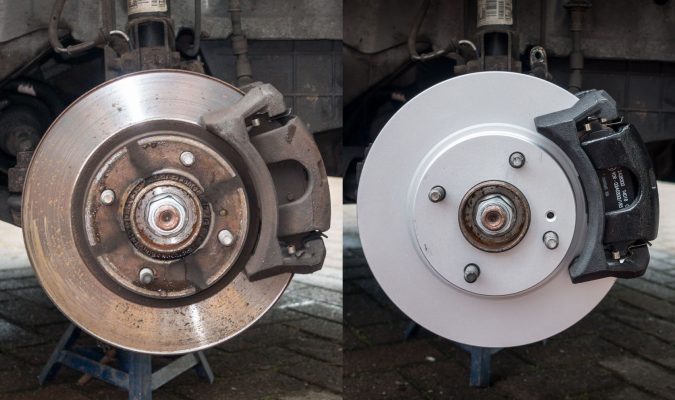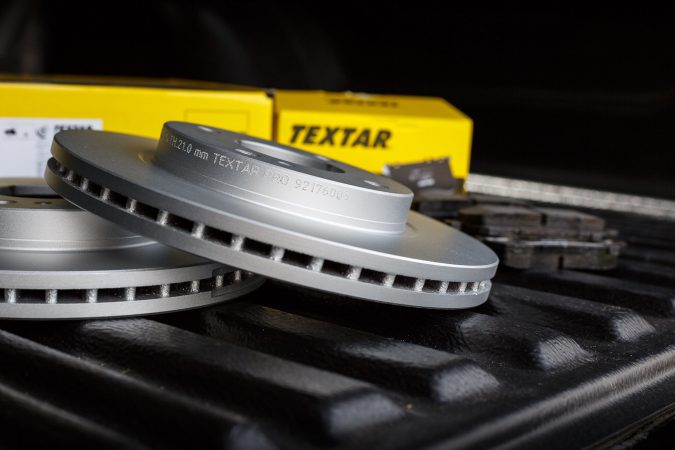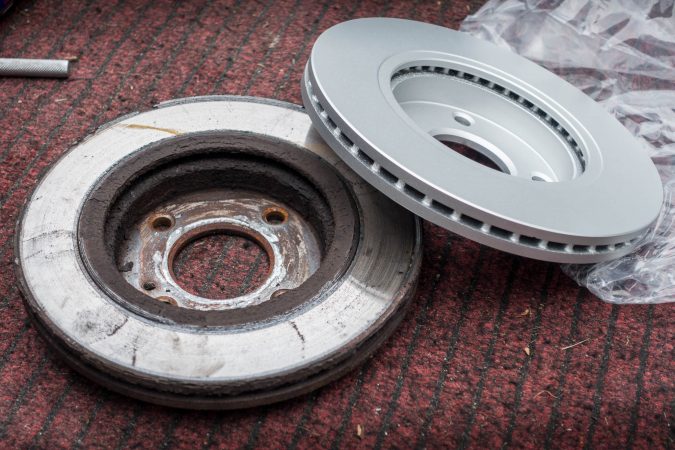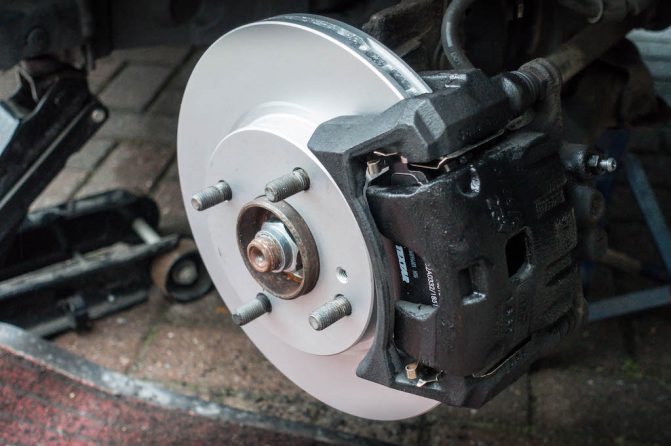If you’ve been to your local auto shop any time recently, you’ll know that brakes and rotors cost a decent amount to replace.
Note: “brakes and rotors” isn’t an entirely correct term, but I’ll address that in the first section of this article. Keep on reading to learn more.
Getting the brakes changed is a reasonably costly – but fairly routine – procedure that everyone will have to go through now and then.
This article will explore what brakes and rotors are, how they work, why you might need new ones, how to look after them, and, finally, how much brakes and rotors cost.
Click here to jump to that section.
Let’s get into it.
Related Content
- Textar Brake Pads and Disc Review
- My Experiences Correctly Fitting Textar Brake Components
- Brake Line Replacement Cost
- Cheapest Place to Get Brakes Done
What Are Brakes and Rotors?
Although we’ll continue with the term “brakes and rotors” for this article, it’s not quite factually accurate.
In reality, “brakes” are made up of two key components (along with many others). These are the “rotors” and the “brake pads”.
The brakes are what make your car stop. Hopefully, that’s something you’re more than aware of already.
Over time, they wear out – for various reasons. Thus, they’ll need swapping out for some new ones.
In this article, we will be looking at how much it costs to replace your brakes – or “brake pads and rotors”.
Brake pads usually need replacing before the rotors, but the advice is usually to change both simultaneously. Alternatively, you could resurface the rotors.
Doing this will cost more, yes, but it is considerably safer and undoubtedly worthwhile.
How Do Brakes And Rotors Work?
The brake pads and rotors are the final product of the braking system in your car. It’s what it’s all there to do.
The rotors are attached to the ends of the vehicle’s axles. The wheels then get put on and secured with wheel nuts/lug nuts.
Rotors spin at the same rate as the axles and the wheels – they’re all basically on one long pole. As the rotors are spinning, they’re passing in between the brake caliper. The caliper is what holds the brake pads.
There are two brake pads for each wheel: one goes outside the rotor, the other on the inside.
When you press the brake pedal, hydraulic pressure causes the caliper to squeeze in towards the rotating rotor (hence the name). The brake pads, attached to the inside of the caliper, press against the rotor. They have very frictional surfaces and, therefore, slow down the rotational speed of the rotor.
Since the rotor is attached to the axle and the wheel, these also slow down. As a result, you, sitting in your car, also slow down.
Rotors are also called discs elsewhere around the world. Click here to go to itstillruns.com and get some more in-depth knowledge on how rotors (or discs) function.
It’s quite a simple system and very similar to ones you find on standard bicycle brakes, although disc brakes are becoming more used on these too.

When Should I Get My Brakes Changed?
There’s no set answer to this question, unfortunately. The brakes need replacing when they need replacing.
The usual rule is to replace both brake pads and rotors at the same time. You don’t have to, but I would highly recommend it. Doing this means that both brakes, on either side of the axle, should balance. It also makes it more apparent to notice any uneven wear.
These need to be changed, legally, once they have gone past a specific legal limit. In the UK, the legal limit for brake pads is a remaining depth of 1.5mm. However, automotive engineerings recommend getting them changed at 3mm.
You can read US laws on light vehicle braking systems here, from Cornell.
Different manufacturers will give differing approximate lifespans for brake components. Some expect brakes to last 25,000 miles, where others boast of brakes that will last for 70,000 or more miles! There’s just no real way to tell.
Personally, I would expect the average person’s brakes to last towards the lower end of that spectrum – about 25,000 miles. If you’re still pushing them long into the 50,000-mile mark, you really should get them checked. Small faults can develop in the pads or rotors that you might overlook without taking the wheel off and disassembling the brake.
An example of one of these very-difficult-to-see problems is when the rotors begin to crack. Remember, although they’re made of sturdy stuff, they almost single-handedly bear the car’s momentum and try to slow it down. Inevitably, this can occasionally lead to mechanical failure.
Rotors can develop minute cracks through them, which are almost impossible to see without a close inspection. Sometimes these cracks are only on the surface and harmless (click here for an example of these on the forum North American Motoring). However, sometimes they run deep through the rotor. Not catching this problem could lead to the rotor shattering while you’re driving – probably while you’re braking. This is a dangerous situation to be in.
It’s crucial to look after your brakes. Keep them happy, and they’ll keep you safe.
What Does It Mean If My Brakes Feel Spongy?
A relatively common problem that people report is a “spongy” brake pedal. That is when you go to press the pedal, and you don’t feel much resistance—your foot sort of keeps on traveling down to the floor of the car. You can feel the brakes applying and working, but they aren’t as efficient as they usually are. The vehicle may also slow down disproportionately to how soft or hard you are pressing the pedal down.
Nine times out of ten, the cause of this problem is to do with brake fluid rather than any mechanical components.
Brake fluid is the liquid that provides the hydraulic pressure for the brakes to work. It is usually a hygroscopic fluid (glycol-ether fluids, such as DOT 3, DOT 4, and DOT 5.1), meaning it absorbs moisture from its immediate environment.
Once this moisture has been taken from the atmosphere, it boils under the hydraulic system’s intense pressure. From this, you get small air pockets. When you have a hydraulic system with air pockets in, it means it won’t work as effectively.
These air bubbles are probably the cause of your spongy-feeling brake pedal. Get the fluid changed. This is referred to as “bleeding the brakes“. You can either do this yourself (with the help of a friend) or get a mechanic to do it for you. You shouldn’t expect to pay more than $100 for this job.
The “spongy” pedal feeling could also come from new brakes. When you get new brakes, it takes time for the pads to “bed in” to the rotor and create a groove. Until then, it can feel a little odd. If the problem persists, make sure to take your car to your local shop.
Why Do Brakes And Rotors Wear Out?
In a sense, they are almost designed to. The friction created by the pads pressing against the rotors inevitably leads to these components’ general wear. If your brakes weren’t wearing out, there would undoubtedly be a severe problem.
As well as general wear, there are a few potential problems that could be making your brakes wear out faster than they would otherwise.
- Badly fitted brakes.
- A “stuck” caliper.
- Badly made brakes.
Badly Fitted Brakes
Brakes aren’t always fitted correctly. The fitter can easily make mistakes.
If a caliper, pad, or rotor hasn’t been installed correctly, it might be causing it to wear disproportionately. You’ll probably feel that something’s wrong when you’re driving – one wheel of the car may feel like it’s braking more or less sharply than the others.
With the brake disassembled, you might see a pad or the rotor with considerably less left to it than the wheel on the other end of the axle. This either indicates a problem with how the brakes were fitted or a problem with the caliper. Perhaps both.
Let’s look at the caliper now.
A Stuck Caliper
The caliper holds the brake pads, one on either side of the rotor. It has a hydraulically-driven piston, using brake fluid, that pushes the brake pads onto the spinning rotor faces.
Occasionally, the pistons in these products become seized. When this happens, it could be due to a manufacturing defect or just bad luck. Once this has happened, the caliper usually needs to be replaced. You could try cleaning it up, but often the most cost-effective method is to replace it.
- If the piston becomes stuck in position, it may be holding the pads against the rotor at all times, even when you aren’t pressing the brake pedal. This, clearly, will cause the brakes on that particular wheel to wear more quickly than the others.
- If the piston becomes stuck in its rest position, the caliper will never press the pads onto the rotor. Therefore, all the other brakes are doing extra work to stop the car.
In both of these situations, you might feel the car pulling to one side when you apply the brake.
Badly Made Brakes Parts
When you get new brakes, it can often be tempting to get the cheapest ones available. Sadly, these cheaper brakes usually don’t last anywhere near as long as the high-quality ones and develop lots of problems along the way.
In fact, it often ends up cheaper to buy the more expensive brake pads and rotors. They will most likely last longer and give you less grief in the process.
Poorly made brakes may wear more quickly than other brakes simply because they’re poorly made.
How Do I Change Brakes and Rotors?

I wouldn’t recommend changing your own brakes unless you know what you’re doing. The brakes are, after all, a hugely important part of your car. They keep you safe. Making a mistake, such as lubricating the wrong part, while working on them could be very costly.
However, it’s certainly possible.
Changing The Brakes And Rotors On Your Car
You will need:
- New brake pads and rotors (I would always recommend changing both at the same time).
- Jack.
- Axle stands.
- Breaker bar.
- Chisels or flathead screwdrivers (for leverage).
- Long-nose pliers.
- Caliper wind-back tool (or equivalent, such as a pair of grips).
- Correctly sized sockets.
- Torque wrench.
- Space to put everything, so you don’t lose anything.
- Hooks for holding the caliper (you can make your own from coat hangar wire).
- Rubber grease.
- Copper grease.
Not put off yet? Okay.
How Much Do Brakes and Rotors Cost?
How much brakes and rotors cost will vary a considerable amount, depending on several factors.
- Whether or not you do the work yourself – hiring someone to fit them for you will incur labor costs. The labor costs themselves can vary quite a bit from state to state.
- What sort of quality you’re after will influence the cost – although budget options are desirable on the surface, you’ll find they wear out more quickly. It’s usually a better idea to pay a little bit more for some more sturdy parts that will last longer.
- The availability of parts – for example, if you have a rarer model, parts will be few and far between. As the supply/demand curve shows us, this means that they’ll cost more.
- How old your car is will make a difference, as it ties into the previous point.
- Whether you get both the pads and rotors changed – now, clearly, just swapping out the pads and leaving the old rotors is more cost-effective. By quite some margin, as well. However, I wouldn’t recommend it. The labor cost will be similar, whether you are changing the pads or not, and therefore you won’t save much if someone else fits the brakes for you. You’ll also potentially end up with a faulty brake. That’s both dangerous and illegal; I would therefore recommend not doing this.

Overall, you should expect to pay $50 to $100 for a budget set of brake pads and rotors. An average set would probably set you back around $100-$200, and premium components might be more than $200+. All of these are approximations, of course.
Labor rates can vary from $50 per hour up to $150 per hour and more. Expect to be charged for about 1.5 hours’ in labor costs. Some shops will charge more than this, others less.
How Much Would Brakes and Rotors Cost If I Replaced Them Myself?
In total, then, to do the work yourself, you’re looking at about $100-$200, assuming you already have all the necessary equipment. If you had to buy a whole set of new tools, it would end up being more expensive than paying someone to do it.
Buying new tools might be worth it, especially if you’re planning to do this multiple times in the future. However, it is an extra immediate cost.
How Much Would Brakes and Rotors Cost If A Mechanic Did The Work For Me?
To hire a mechanic to fit the brakes for you is likely to cost about $300-$500+.
These figures are a guess based on personal experience. Depending on many factors, they could charge you much more (or less) than these numbers.
What Else Should I Be Aware Of?
We have looked at brake fluid before – earlier in this article. It’s worth mentioning, though, how the braking system works as a whole.
This YouTube video explains it rather nicely.
It’s important to look after your brakes as much as possible – the rotors and pads are just part of the system. They’re a vital part, certainly, but the rest of it is essential too.
Here are a few tips to make your brakes last as long as possible.
- Regular maintenance – okay, this one is obvious. I recommend having the pads and rotors checked or serviced at least once a year. Checking or servicing involves removing the wheel and disassembling the brake, taking a good look at the rotor, the pads, and the caliper. You should note any excessive or uneven wear. Part of your regular maintenance should also be checking the brake fluid level and condition. Problems such as dark, dirty-looking brake fluid or a low level will need fixing. If any of these symptoms present themselves, it’s time to take the car down to the local auto shop.
- Watch out for any warning signs – you might notice the car pulling to one side under braking, a burning smell coming from the brakes, very hot rotors (just by putting your hand near it), screeching or scraping noises, ABS problems, a “spongy”-feeling brake pedal, not slowing down as quickly as you usually do… the list is almost endless. Don’t ignore these signs! It’s much better to catch a problem earlier rather than later.
- Use engine braking as much as possible. If you’ve not learned to drive a car with a manual transmission (“stick shift”), you might not grasp the importance of this so much. With an automatic transmission, it shifts the gears for you. As you apply the brakes, you might be unaware of the engine braking for you. Engine braking is a vital part of stopping and, in fact, does quite a lot of the work by itself. When driving a manual, you’ll be aware of the importance of keeping the car in gear until you’ve almost stopped. Check out the first video below for a more in-depth explanation.
- Get good quality brakes! The brakes stop the car. It’s important to get ones that are definitely going to work.
- You. Usually. Don’t. Need. To. Use. The. Brake. On. A. Freeway. This is more important than you might realize. With a few obvious exceptions (for example, accidents, stationary or very-slow-moving traffic, or reacting to dangerous driving from others), you shouldn’t use the brake to slow down on a freeway. If you need to reduce your speed, just lift off the throttle pedal. Natural resistance in the engine – engine braking – will reduce your speed for you. Using the brake on the freeway causes others to brake behind you, starting a ripple effect that can eventually lead to congestion. As well as this, the less you use your brakes, the longer they’ll last. This effect has been scientifically demonstrated (see the below video).
What Is Engine Braking?
Traffic Theory – Why Shouldn’t I Brake On The Freeway?
Why Do Brakes and Rotors Cost So Much?
Brakes and rotors cost what they do simply due to the standard consumer process.
The original manufacturer produces the goods – in this case, brake pads and rotors. They might even contract the work out to other local or international manufacturing businesses. After this, they sell the parts to the distributor. The manufacturer must make a profit on this transaction, and then tax is also included.
From here, the distributor sells them on again. They might go to another distributor, a mechanic, an auto shop, or a final customer. Similarly, the business must make a profit, or it will go bankrupt. Tax is also added on.
The more this process happens, the higher the final cost to the customer will be.
Of course, higher quality brakes are made with more intricate designs and better-quality materials, too. For this reason, as well, they’ll cost you more.
The best way to keep your brakes and rotors’ cost down is to purchase directly from a distributor.
How Do I Change My Brakes And Rotors As Cost-Effectively As Possible?
In conclusion, then, we have been examining how much brakes and rotors cost. The most cost-effective way of changing them is to do the work yourself. This has its downsides, too, though, in that you won’t have any warranties against any mistakes you could make.
If this is the route you want to go down, I would recommend getting a mechanically-minded close friend to change your brakes for you, if you’re at all unsure. Again, this wouldn’t come with a legal warranty.
To be on the safe side, it’s best to get a certified garage to replace your pads and rotors for you. It will cost more but carries the least amount of risk.
Facts about Brake Maintenance and Cost:
- Properly working brakes are crucial for safe driving, and brake work is an important maintenance procedure for every vehicle.
- Brake pads, rotors, and calipers are the main components of a brake system, and each has a different lifespan that depends on factors such as driving conditions, driving habits, and materials used.
- Quality brake pads can last between 30,000 and 70,000 miles, but this can vary based on the above factors.
- Brake rotors and calipers are more expensive and often more complicated to replace than brake pads, and their life cycles also depend on various factors. Regularly flushing brake fluid can extend the life of calipers by preventing corrosion.
- When getting a brake job quote from a mechanic, they may ask about the brand, make, and model of the vehicle, the type of driving the vehicle is used for, and the type of materials preferred for brake pads.
- The cost of new brakes varies depending on factors such as hourly rates and parts pricing, but for brake pad replacement only, the cost can range from $115 to $270 per axle for parts and labor, for replacing brake pads.
- Replacing worn rotors with new brake pads is critical for optimal braking and safety, and rotors can cost between $30 and $75 each. Higher-quality rotors may cost more. So, bear this in mind if you’re learning how to replace brake pads.
- Calipers are the most expensive and difficult component to replace in a brake system, with a single caliper potentially costing up to $130. A complete brake repair can cost between $300 and $800 or more, depending on the make and model of the vehicle.
- DIY brake maintenance can save money, but safety should be the top priority, and it may be best to consult with a professional mechanic or installer.


Is there a cheaper versions of these?